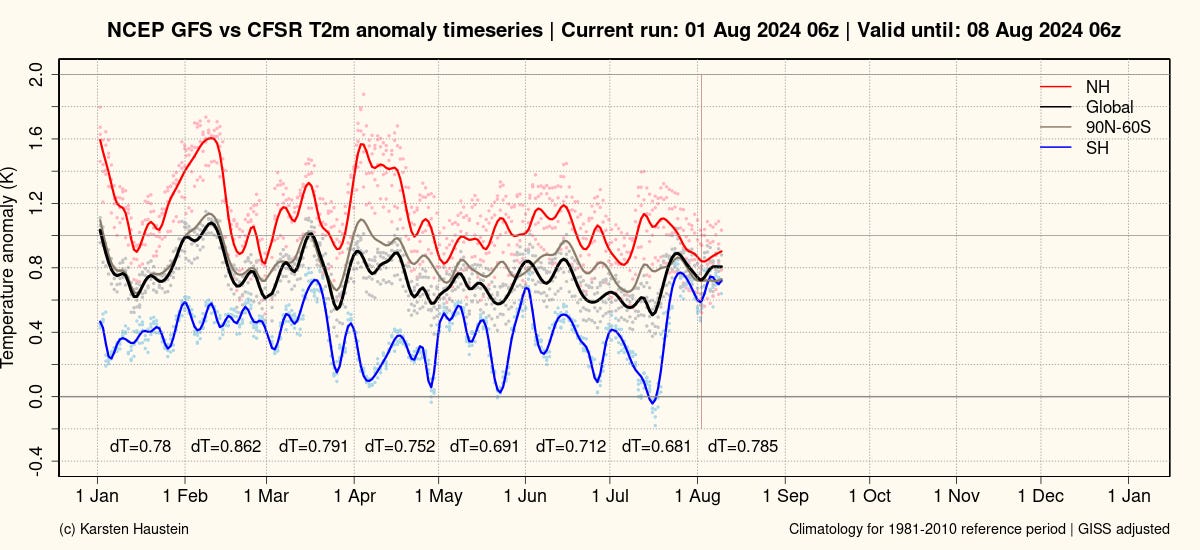
TL;DR: Here’s the top six news items of note in climate news for Aotearoa-NZ this week, and a discussion above between Bernard Hickey and The Kākā’s climate correspondent Cathrine Dyer:
The WHO reports a 30% increase in heat-related deaths worldwide over the past two decades with numbers set to swell (as we all swelter).
Wait and see, says Zeke Hausfather: Climate scientists are holding out for as long as possible in the hope that global surface temperatures will self-correct to a level closer to their model paths in August.
A story about how oil companies sold the US on a fake climate change solution, simultaneously swindling billions of dollars of taxpayer money to support the grift, is gaining ground since hearings in the US Senate wound down last month.
As support for ‘voluntary off-setting’ hits the skids, a replacement concept is now emerging to help corporates achieve their targets, even when they fail to sufficiently reduce their own emissions. Is it real, or just another way to greenwash?
The call goes out to make your voice heard, with submissions on the government’s Emissions Reduction Plan (ERP) set to close on 17 August.
The Government announced it was looking to import LNG to generate elecricity after a surge in wholesale prices that is forcing factories to close.
(See more detail and analysis below, and in the video and podcast above. Cathrine Dyer’s journalism on climate and the environment is available free to all paying and non-paying subscribers to The Kākā and the public. It is made possible by subscribers signing up to the paid tier to ensure this sort of public interest journalism is fully available in public to read, listen to and share. Cathrine wrote the wrap. Bernard edited it. Lynn copy-edited and illustrated it.)
1. WHO warns of ongoing surge in heat-related deaths
As athletes and spectators alike suffered through sauna-like conditions at the Paris Olympics, the UN has pointed out that heat-stress is the leading cause of climate-related deaths in the region. According to a World Health Organisation (WHO) report, there has been a 30% increase in heat-related deaths worldwide over the past two decades.
A staggering 175,000 people die from heat-related causes every year in Europe and that figure is set to soar in line with our steadily warming planet. That’s the warning from the UN World Health Organization (WHO), which said on Friday that European countries are seeing temperatures rise at around twice the global average.
[...] That message echoes the Call to Action on Extreme Heat by UN Secretary-General António Guterres, who insisted that Earth “is becoming hotter and more dangerous for everyone, everywhere”.
In some places around the world, the climate crisis is already driving temperatures up to unbearable levels, WHO noted. Estimates show that globally, approximately 489,000 heat-related deaths occurred each year between 2000 and 2019, with the European Region accounting for 36 per cent or on average more than 175,000 lives every year
Mr. Guterres’s comments came in the week that saw the three warmest days recorded on Earth in recent history, according to one of the datasets that the UN World Meteorological Organization (WMO) uses to monitor the climate.
Source: UN News
2. ‘We’ll know by August’
Meantime, climate scientist Zeke Hausfather pushes back against the dawning realisation that global temperatures have already established a new normal that is 1.5˚C above the pre-industrial level, suggesting we ‘wait and see’ what August brings.
Temperatures in the southern hemisphere (the blue line in the chart below) were pushed up in the last two weeks of July by a warming spike in Antarctica which soared nearly 30˚C above normal.
Daily global and hemispheric temperatures in the NCEP GFS reanalysis product, including a 7-day forecast. Anomalies shown relative to a 1981-2010 baseline. Sourced from Karsten Haustein’s climate tracking site.
Hausfather suggests that this anomalous situation in Antarctica, which is generally subject to high variability, is likely to disappear, leaving August temperatures to drop slightly below last year’s.
Earlier this year NASA’s Gavin Schmidt and I separately wrote that the evolution of global temperatures in 2024 would be important to tell us if the “gobsmacking” conditions we saw in the latter half of 2023 represented a new persistent condition for the climate or more of a temporary phenomenon.
Gavin suggested that we would have a better sense by August if conditions were stabilizing or the climate was heading into “uncharted territory”.
With August almost upon us we remain in something of a liminal space. Both June and July were notably warmer than I expected earlier in the year (coming in 0.4C and 0.3C respectively above the last big El Nino year of 2016). At the same time, we have moved out of record territory, and we still expect some additional cooling influence from fading El Nino conditions and potential La Nina development.
So I think we will still have to wait and see, though if the spike in temperatures over the past few weeks persists to push August 2024 to set a new record it would be a worrying sign.
Source: The Climate Brink
The problem is that temperatures in August last year were already 1.5˚C above the pre-industrial average according to the EU’s Copernicus programme.
A new record would be really alarming, but one would think that anything near to last year’s “gobsmacking” conditions would still represent a worrying ‘persistence’. The requirement for a ‘new record’ to spark concern sounds like the goalposts are being shifted.
3. Eyes on fossil fuel companies’ cynical ‘solutions’ ploy
Award-winning investigative journalist, Amy Westervelt’s piece, supported by the Pulitzer Centre and published in Vox, as well as her own site Drilled at the end of July is gaining traction.
The report shows how fossil-fuel companies have been heavily marketing solutions, such as Carbon Capture and Storage (CCS) and biofuels, that they don’t really believe in themselves.
Her reporting has been closely following revelations from a three-year US House and Senate Democrat investigation into the fossil fuel industry’s role in climate disinformation.
The Intergovernmental Panel on Climate Change (IPCC) has said carbon capture might be necessary to reduce the emissions of certain “hard to abate” sectors like steel, concrete, and some chemical manufacturing, but noted that in the best-case scenario, with carbon capture technology working flawlessly and deployed at large scale, it could only account for a little over 2 percent of global carbon emissions reductions by 2030.
That hasn’t stopped major oil companies from claiming that carbon capture and storage “will be essential for helping society achieve net-zero emissions,” that they are delivering “carbon capture for American industry,” working on reducing emissions in their own businesses (also referred to as “carbon intensity”), and delivering “heavy industry with low emissions.” But internal documents obtained during the federal investigation, as well as information that industry whistleblowers shared with Drilled and Vox, reveal an industry that is decidedly more realistic about the emissions-reduction potential of carbon capture and storage technology, or CCS, than it presents publicly.
[...] While Shell’s optimistic projection envisions 10,000 large-scale CCS facilities operational by 2070, with more than 2,500 facilities by 2050, Exxon predicts somewhere between 250 and 500 facilities by 2050. Elsewhere in the scenario, Exxon also envisions that “global scale is limited” for CCS and hydrogen tech by 2050.
Exxon’s past projections were much more in line with what critics of CCS have been saying for years. The IPCC, for example, has said that even if realized at its full announced potential, CCS would only account for about 2.4 percent of the world’s carbon mitigation by 2030. In its fact sheet on CCS, the Institute for Energy Economics and Financial Analysis (IEEFA), a nonprofit, nonpartisan think tank in Ohio that produces market-based research on the energy transition, states: “It’s worth noting that not one single CCS project has ever reached its target CO2 capture rate.”
It has also been revealed that Exxon’s own carbon capture project at its LaBarge Shute Creek gas facility, often touted by the industry as one of the largest successful, working projects has been venting half of its captured emissions back into the atmosphere, after selling most of the other half to various oilfield operators for enhanced oil recovery (EOR). Just 6 million tonnes (around 3% of the captured emissions) have been permanently sequestered underground during the facility’s 35 years in operation.
Thanks to prolific lobbying and a campaign promoting “CCS enabling narratives” by fossil fuel companies, US taxpayers are now funding CCS through a tax credit that pays as much as $85 per metric ton of carbon that is sequestered and up to $60 per ton for carbon that is stored, then used for EOR, a longstanding practice that makes oil and gasfields more profitable!
The stored emissions for which the tax credit can be claimed are entirely self-reported and the Environmental Protection Agency (EPA) is not verifying how much carbon is actually being stored. Westervelt’s reporting includes, among many other startling revelations, what happens when CO2 pipes transporting captured carbon leak (you may not want to know if you enjoy sleeping at night).
The whole report is well worth reading before the industry narratives take root here in Aotearoa.
4. A new mechanism in favour, but is it more greenwashing?
In other news, The Financial Times is reporting on a new financial mechanism to ‘unleash the power of capital’ and aid companies to meet their emissions targets as carbon offsets go out of vogue.
The certificates sound a lot like carbon offsets, the controversial voluntary credits that companies buy to prove that they have helped cut emissions somewhere else, often by planting trees or distributing cleaner cooking stoves. But there is a crucial difference that avoids some of the problems that led the world’s leading arbiter of corporate climate targets to declare carbon offsets were mostly “ineffective”. The certificates are “carbon insets” — they reduce carbon in a traceable way from the relevant supply chain, rather than through some unconnected activity. [...] The US Treasury department said using insets was preferable to offsets for corporate buyers in its recent paper on voluntary carbon markets.
The example used in the FT article involves a third-party company paying to subsidise an airline’s use of biofuels, made from used oils, fats and renewable energy to make fuel, that reduces emissions by as much as 70% (such approaches have been criticised elsewhere for their lack of scalability). The biofuel is more expensive than regular aviation fuel, so airlines won’t use it without a subsidy.
This sounds a lot like a plan to have one set of unsustainable (but profitable) industries subsidise another unsustainable industry so that they can all stay afloat for as long as possible. Indeed, the FT article admits that “[s]ome environmentalists warn that they could set back the ultimate goal of curbing global warming because they remove pressure on companies and people to change their behaviour. With certificates, companies voluntarily pay more to fly rather than flying less. They also can be subject to the same fraud and abuse as offsets” before proclaiming the approach a win.
The underlying approach is ‘same, but different’ to that being trialled in Aotearoa by the Toha Network, to much better effect. Toha is focused on shifting funding to frontline communities engaged in repairing and regenerating local landscapes. Toha’s MAHI is a digital token that is used to pay for work that is verified through a system known as ‘action- or output-based funding’. The premise is considerably more promising, but still highly dependent on the integrity of the executing organisation.
While the ‘carbon inset’ concept described by FT seems, at best, an incremental improvement on carbon off-sets, a critical difference with Toha’s approach is that it doesn’t aim to provide a claimable emissions reduction for the purchasing entity. It simply enables organisations to support activities such as nature repair and restoration, land stewardship, and invasive species management in a verified and measurable way.
5. Speak up on the emissions plan
And finally, public submissions on the Government’s Emissions Reduction Plan close on 17 August 211.
Catherine Knight’s excellent opinion piece in Newsroom this week reiterates New Zealand climate scientist James Renwick’s call to make your voice heard.
We further encourage you to make your voice heard beyond the submission process, which can be a very controlled form of public feedback with no guaranteed response. Use it but go further. It is increasingly clear that a proportionate response to climate change will not arise from governments or institutions embedded in the status quo, but from the actions of a concerned public.
6. Always going for fossil fuels first
The Government announced it was looking to import LNG to generate elecricity after a surge in wholesale prices that is forcing factories to close. We talked more about that in this week’s Hoon.
Ka kite ano
Bernard and Cathrine
Corrected online from August 17 to August 21.


















Share this post